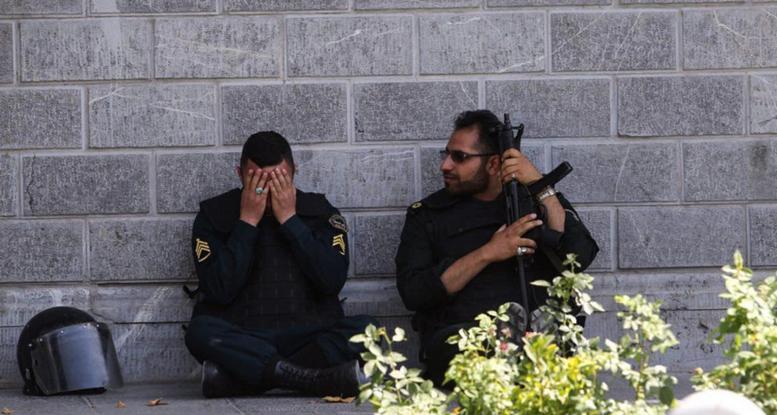
Islamic State Accomplished At Least One Terrible Goal
The Islamic State (IS) extremist group struck Iran — and did so with sadistic aplomb. If terrorism is theater, then IS on June 7 directed an award-winning performance of the most grotesque kind in the country’s capital, Tehran.
The attack was striking both in terms of location and method. Attackers struck both the national parliament and the mausoleum of the Islamic republic’s founder, Ayatollah Ruhollah Khomeini — two of the state’s most symbolic sites.
Even more strikingly, IS, the most media-savvy terror organization in modern history, appears to have live-streamed the attacks. Video uploaded by the attackers as they went shooting from room to room in the parliament appeared on the group’s media outlet, the Aamaq news agency. The video lasts for just under 30 seconds and shows one of the gunman near the body of a presumed victim while a voice on the video praises God and says in Arabic: “Do you think we will leave? We will remain, God willing.”
It is estimated that 12 people died (11 in parliament and one at the mausoleum), while six attackers were killed. At the parliament, Iranian security forces engaged in an hourslong shoot-out with the militants inside — killing all five there. One was killed at the mausoleum. But it is important to remember that killing and wounding is only ever a secondary aim of terrorism. Its primary concern is, as its name implies, to terrorize. Terror attacks are designed to puff up the organization responsible, making it look bigger and more important than it actually is. This is a goal for terror groups at the best of times, but for IS — which will soon lose Iraq’s second-largest city, Mosul, and is now facing a major assault on its major urban stronghold in Syria, Raqqa — the need to remain in the public consciousness is greater than ever.
By gaining access to the Iranian parliament (though nowhere near the actual debating chamber), it has done exactly that. It is a crime of the utmost brazenness and brutality.
And while this is the first time that IS has struck Iran, the group has been trying to do just that for some time now – most recently in a March video in which an IS fighter speaking Persian urged Iranian Sunnis to target Iran.
7. It was because of the live feed posted from inside Bangladesh cafe last yr that analysts like @AmarAmarasingam were able to see IS link
— Rukmini Callimachi (@rcallimachi) June 7, 2017
In reality, the only surprise is that the attacks did not happen sooner. Iran, a Shi’a power, has been waging war in both Iraq and Syria against Sunni Arab forces. In Iraq, the Iranian-backed Shi’a militias have fought against IS, as well as committing atrocities against Sunni civilians in towns they have “liberated” from the group. In Syria, meanwhile, Tehran is devoted to propping up its ally, the Alawite (a branch of Shi’a Islam) President Bashar al-Assad, and has contributed to the widespread massacre of Sunnis in the process.
As Rashad Ali, senior fellow at the Institute for Strategic Dialogue, observes, “Iran has been engaging in both propping up the Syrian and Iraqi regimes and also vying for control of post-IS territory through both their own military activities and their proxies in the Iraqi regime and Tehran’s various militia groups. The resultant anger among a large population of Sunnis has had many manifestations in Iraq, and it was inevitable that it would have the same impact on many aggrieved Sunnis who perceive Iran to be at the center of a conspiracy against Sunnis in the region, especially given the growing power of the Shi’a crescent (the line of contiguous Shi’a or strong Shi’a-minority states across the Middle East) and the repeated massacres of Sunnis at Shi’a or Assadist hands.”
He continues: “This is at the root of this attack. Despite the pragmatic and cynical cooperation between the Assad regime, [Islamic State], Al-Qaeda, and Iran, I don’t believe, as many in the region are suggesting, that this was a false-flag operation cooked up between them. But Sunni grievances have allowed such theories to gain traction.”
As ever, it is impossible to escape sectarianism in the Middle East. Just hours after the attack, Iran’s Islamic Revolutionary Guards Corps (IRGC) released a statement accusing Saudi Arabia and the United States of being behind the attacks: “This terrorist action, coming one week after the meeting of the president of the United States with the leader of one of the region’s reactionary governments (Saudi Arabia) … shows they are involved in this savage action,” it said in a statement.
IS vowed that there would be more attacks on Iran and has, at any rate, achieved a major goal: It has once more pushed itself to the forefront of global consciousness. Even State Department spokeswoman Heather Nauert weighed in on the attacks, saying that the United States was sending thoughts and prayers to the Iranian people and that “the depravity of terrorism has no place in a peaceful, civilized world.”
As yet another IS atrocity hits the news, as yet more people are killed and maimed, the group continues to exist on a media supply of oxygen, even as it is slowly asphyxiated on the ground in the Middle East. IS has made a clear choice: It will not give up. It will not, as the Welsh poet Dylan Thomas so aptly put it, “go gentle into that good night.” Instead, inverting his paean to life, IS, which worships only death, will — until its last breath — “rage, rage against the dying of the light.”
And the world — from London to Tehran — will continue to suffer.
Source: rferl





